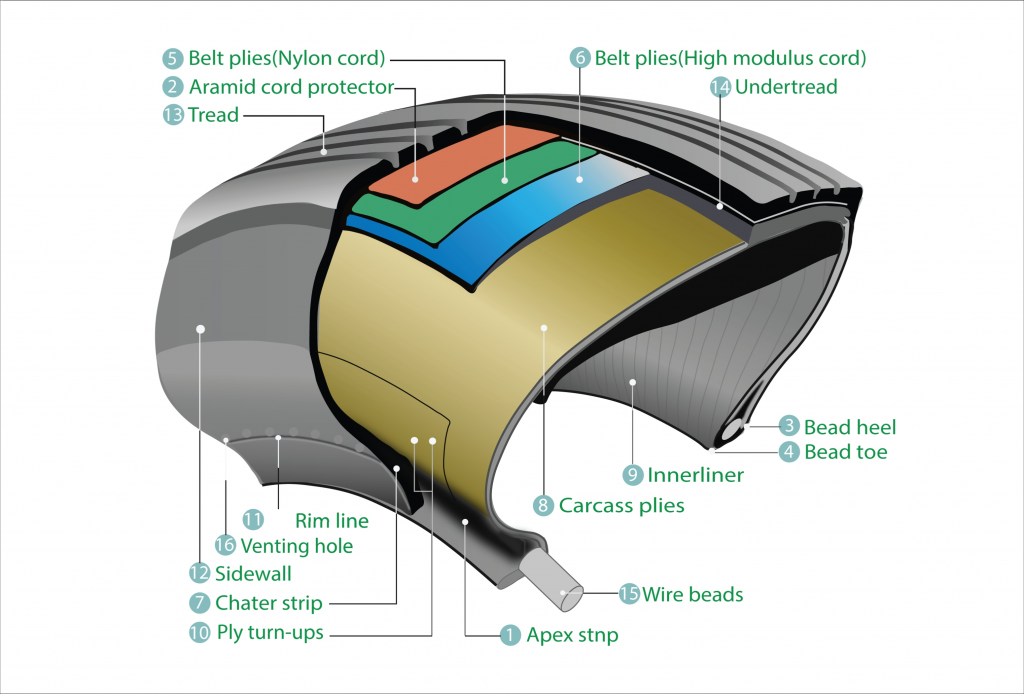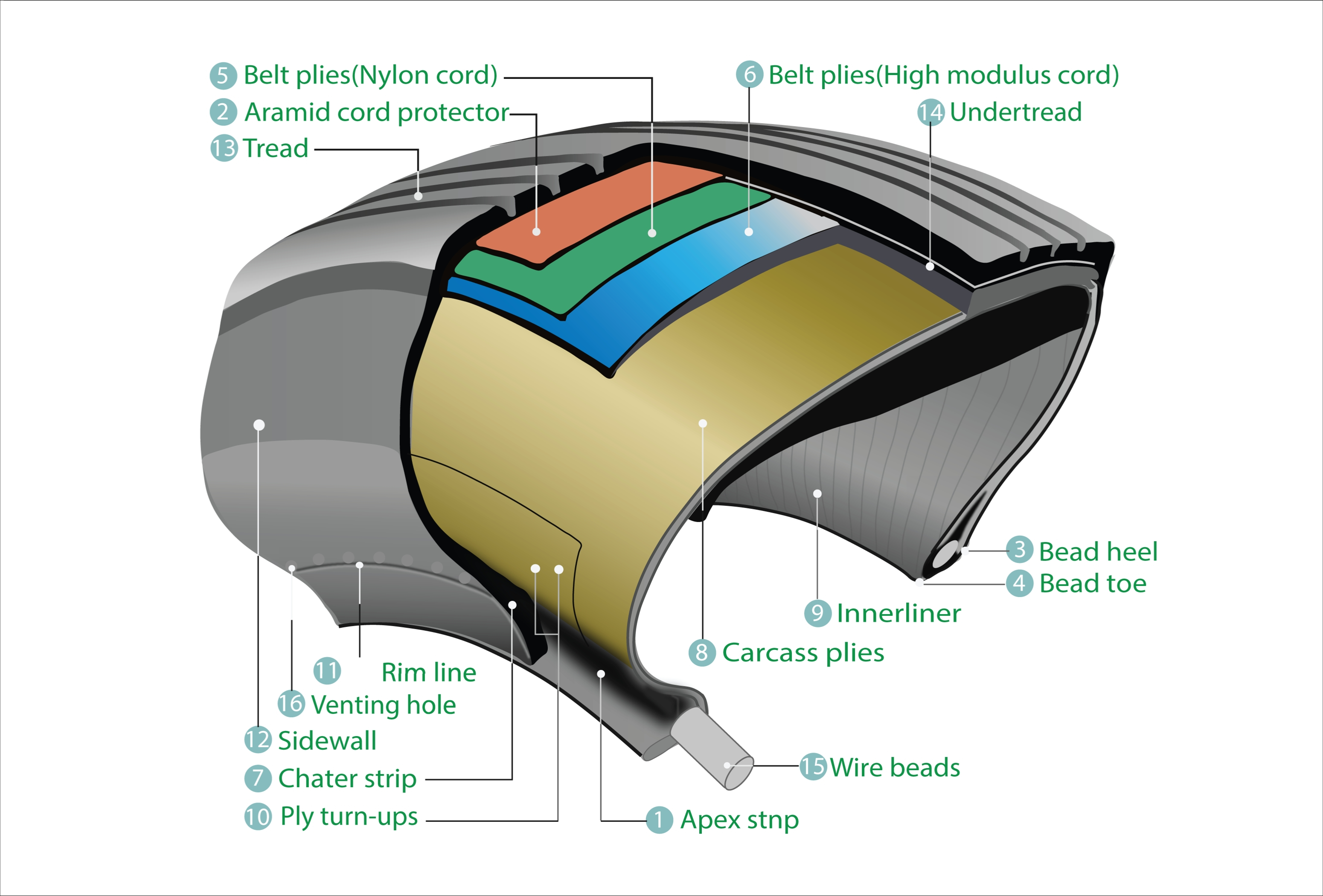This article is part of the series The Trials and Jubilations of Working in the Rubber Industry: Rubber Worker Storiesand is supported by the Region of Waterloo Arts Fund.
In Between Worlds, Juliana’s grandfather and uncle worked in a factory that made tires from rubber. Like many aspects of the series, there is truth in the fiction: In the 19th and 20th centuries, Waterloo Region in Ontario, Canada, had a strong manufacturing industry, and rubber was turned into lots of different products in factories. (Uncle Peter actually worked in two rubber factories. This reflects what happened in real life when one factory closed in Kitchener in 1993.) In this second of a series of three articles, you’ll learn how tires were built during Opa’s time.
The Basics of Building Tires
Building a tire is like baking a cake. For the dessert, you mix dry and wet ingredients, then pour them into a round or square pan, whichever shape you want. Depending on the exact ingredients and method, however, you can end up with angel food cake, pound cake, or even Boston Cream Pie. Similar things happen with tires. They are made out of common ingredients, but you wouldn’t put a big, bulky tractor tire on a racing car; the ordinary driver doesn’t need to pay a premium for racing tires; and winter tires aren’t the best for running in summer heat.
Because of all these variations, it’s impossible to explain in one blog post how all tires are made. In addition, advances in manufacturing and technology have changed the process. In this blog post, though, I’ll explain the basic steps in some of Kitchener’s rubber factories in the 19th and 20th centuries.
The Basic Components of a Tire
Tires have three basic components: fabric, beading, and the rubber compound.
According to a Uniroyal brochure that explained how a tire was made[1], a conventional passenger-car tire weighed about 22 lbs. broken down as follows:
- 2.5 lbs. natural rubber
- 7.5 lbs. synthetic rubber
- 6 lbs. carbon black
- 4 lbs. chemicals and oils
- 1.5 lbs. fabric
- 0.5 lbs. steel for bead wire
The first four components were compounded in the mills and Banbury mixers before being used as coating for fabric and bead wire.

Using Fabric in Tires
Fabric gives shape and strength to the carcass of the tire.
Fabric arrived at a tire plant and was passed through a calendar, which had nothing to do with days, months, or years. Instead, calendars were large machines with giant rollers that coated the fabric with rubber on each side. The process had to be so exact that, according to Uniroyal’s brochure, “the thickness of the rubber on each side of the fabric [was] not allowed to vary more than .0005 of an inch.”
Don D. started working for Dominion Tire—which later became Uniroyal—in 1953. One of his jobs was in calendaring, or producing this rubber-coated fabric that became the first layer in building a tire.
Using Steel Wire to Make Tire Beads
Don S. worked in the Uniroyal prep department as a bead coiler from 1980 to 1990.
Tire beads have nothing to do with the decorative objects used in crafts. Instead, tire beads are lengths of steel wire. Whereas the rubber-coated fabric created in the calendaring process provides the shape and strength of the tire, a bead coil provides the grip necessary to keep the tire attached to the rim of the wheel.
Don S. says beading was one of the best-paying jobs in that department, which also meant it was one of the worst jobs. Difficult or not, Don enjoyed working with the machinery: “It was a mechanical beast that had lots of gears and stuff like that, and I found that always fascinating.”
Building a Tire
Tire building in the 19th, 20th and even early 21st centuries in Waterloo Region was mostly a manual process.
Basically, tires go through three stages:
- Assembly
- Curing
- Quality control
A video is the easiest way to show how the job was done. This first clip is from Brunswick Tires in the United States in 1934. Tires were manufactured somewhat differently in Kitchener. For example, Brunswick Tires made the fabric onsite. But the three stages happened in both places.
Notice how many people were involved in the process.
Assembling a tire, as the video shows, involved manually lining up the rubber-coated fabric, beading, other layers, and the tread on a drum.
Wayne, who worked at the Goodrich plant on Goodrich Drive in Kitchener from 1971 to 1990, built truck tires for a time.
“It was quite dangerous, when I think back,” he says. He recalls one task that involved the drum, with a band of rubber on it, spinning very fast while the builder passed a rod with bearings over the assembly.
“Every now and then, one of these things would get caught. Some people would stand on the brake pedal when you did it, just in case something happened.”
Because of the physical demands of building truck tires, Goodrich required that all truck builders be at least six feet tall, 200 lbs., and 21 years old or older.
Mark worked on and off at the Uniroyal plant until 1988, including as a truck-tire builder.
“It was very hard, very slogging, and you’re tired at the end of the day,” he says.
Next, watch this video from German tire manufacturer Continental Tyres. Although it’s unclear when the video was made, it was posted in 2015, 81 years after Brunswick Tire produced its clip. Notice the lack of people in the newer video and how much work the machines do.
Did you also see how clean the factory is? I was told many times that the rubber factories in Waterloo Region were filthy. Several men said they would come home and blow carbon black out of their noses. Even when the factories shut down for the last two weeks of July every year for maintenance, they were not fully cleaned.
Curing Tires
We can accurately say that each tire building station was manned by one individual who constructed each tire by hand. However, other workers would bring him the materials he needed to construct the tires. Once a worker finished building a tire, he lifted it off the drum and onto a conveyer, which transported it to curing. As the videos show, this involved immersing each tire in a hot bath to give the tire its final properties, including imprinting a pattern onto the tread.
Quality Control
Tire construction is governed by strict safety laws in Canada and the United States, so Uniroyal, BF Goodrich, and all other tire manufacturers have to test their tires frequently.
Jim and his team at Goodrich tested about five out of 100 different types of tires being manufactured each month. They subjected tires to high-speed, endurance, and bruise and puncture tests.
The bruise and puncture test was the most dangerous. The tire was mounted on a split rim housed in a cage, inflated, then punctured down the centre until the tire broke.
“So, it’d be an awful loud bang when you actually would destroy the tire,” says Jim, “and it would scare the living bejesus out of somebody.”
If the split rim was assembled incorrectly, however, the test could cause the tire to explode with such force that it would damage the cage.
“I personally knew a guy I went to school with who was involved with mounting one of these tires locally at a tractor-trailer yard and actually lost his life when this thing came apart,” says Jim.
Jim believes technology advances have made the job safer since he retired over a decade ago. However, overinflating tires can still be dangerous.
Quality control didn’t involve just testing tires. Jim’s team also inspected different samples of rubber and fabric that went into making a tire.
“We would check those every shift, every day, three times a day,” he says.
They also inspected machines and products throughout the stages of assembly.
Lots of Variation in Tire Building
The performance requirements for airplane tires are vastly different from those for a sedan’s all-season tires. In other words, they required different recipes, and the workers had to learn each customer’s recipe book. It was exhausting work that has left its physical toll on many workers’ bodies. Today, much of the physical work is done by machines, making it easier to meet customer requirements and lessening the physical damage for workers.
Despite the physical toll, these jobs were meaningful in many ways. Next, we’ll discuss why these people (mostly men) worked at these factories for decades, often encouraging family members to sign up, too.
*Two participants in the oral history project were named Don and had last names that began with the same letter. So, I’ve used letters from the ends of their last names instead: Don D. and Don S.
[1] Uniroyal. How We Build a Tire. Date unknown, although judging by the images, probably the 1970s.

We manage all data submitted as outlined in our privacy policy.